Unlike Casa Uborka, we residents of Casa Brigouras have not been making pizza for the better part of a decade. Like Bernard, though, we have certainly been eating it that long, and would also claim it as our very favorite food. (Well, the -ouras half of our clan makes that claim. The Brig- half may prefer kippers or something.)
As a New Yorker, you’re born with a very strong opinion about pizza. And if you happen to migrate here later in life, it’s part of the You’re A Local Now kit, which also includes the ability to say “heyyyy! I’M WALKIN HERE!” like you mean it.
After a decade of eating the best pizza in the whole entire world (if you’re wondering, my personal greats are Nick’s in Forest Hills and Lucali in Carroll Gardens tied for classic Neapolitan pie, La Villa in Park Slope for grandma pie on focaccia, and DiFara’s in Midwood for transcendent classic New York slice) I decided to try importing that excellence into my own kitchen. Here is that chronicle.
Dough
I started out buying my dough from the local pizzaolo, since I figured he’s already making edible pizza and I was really intimidated by dough. This year, though, I decided to sack up already and try my hand at it, mostly because I was given Smitten Kitchen’s incredibly excellent cookbook, and in reading it (what, you don’t all read your cookbooks start to finish?) I noticed that she walks you through it very simply. And when Deb offers to take your hand and dispel your fears, you can trust that the results will be marvelous. So now I make her leisurely pizza dough first thing in the morning. It only takes about 15 minutes, and I find it invigorating to knead the dough while staring out our eastward-facing kitchen window and thinking about the day. Deb’s dough recipe makes one pizza pie of about 13-15 inches in width (it’s quite a thin crust, what is this, Chicago?), and it’s very forgiving. I’ve recently been told to try 00 flour from Italy which is more specifically suited for pizza, but so far my pies have been delicious with regular all-purpose flour.
Sauce
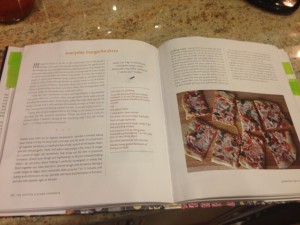 When I first started making pizzas with the pizzaolo’s dough, I also used cooked sauces (made at home). I would simply preserve some of the marinara I make regularly for pasta, and sauce the pie with that. However, in my research I learned that traditionally, Neapolitan pizza is made with raw tomato sauce, since the sauce will cook on the pie and this leaves you with the fresh, slightly sweet tomato flavor, and none of the tangy acidity of already-cooked sauce. So now I follow Smitten’s sauce recipe, as well, using 100% pure tomatoes (usually Pomi’s wonderful strained variety which has the right consistency). I add a few pinches of red pepper flakes, salt, a pinch of sugar and a drop or two of red wine vinegar. This is very much a taste-and-adjust process.
When I first started making pizzas with the pizzaolo’s dough, I also used cooked sauces (made at home). I would simply preserve some of the marinara I make regularly for pasta, and sauce the pie with that. However, in my research I learned that traditionally, Neapolitan pizza is made with raw tomato sauce, since the sauce will cook on the pie and this leaves you with the fresh, slightly sweet tomato flavor, and none of the tangy acidity of already-cooked sauce. So now I follow Smitten’s sauce recipe, as well, using 100% pure tomatoes (usually Pomi’s wonderful strained variety which has the right consistency). I add a few pinches of red pepper flakes, salt, a pinch of sugar and a drop or two of red wine vinegar. This is very much a taste-and-adjust process.
Cheese
I’m not militantly committed to either my dough or my sauce recipe, but I am absolutely firm on the cheese; it has to be fresh (and freshly purchased) whole milk salted mozzarella. I’ve tried the pie with pre-shredded or packaged mozz and it never quite tastes like the pies at Lucali or Nick’s, which is what I’m always aiming for. (For more words than you might ever want to read about fresh mozzarella, here’s my favorite food nerd, J Kenji Lopez-Alt from at Serious Eats, waxing quite lyrical on the subject.) I shred it coarsely while the pie is cooking, and roughly a cup of cheese usually does the trick.
Making the pie
So now that I’ve bored most of you to tears with the components of my perfect Neapolitan pie, here’s how it actually happens.
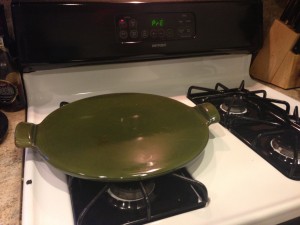 1. I get home and take the dough out of the fridge and start pre-heating the stone, with the oven set to 500F. Cook’s Illustrated, the most pedantic magazine you’ve ever read about cooking and my absolute bible of extreme food nerdery, says a stone pre-heated for 15 minutes will have the surface temperature of 291F, while a stone pre-heated for an hour will actually reach 509F, and the hottest possible stone means the best char on the crust, approximating what happens in a 900F commercial pizza oven.
1. I get home and take the dough out of the fridge and start pre-heating the stone, with the oven set to 500F. Cook’s Illustrated, the most pedantic magazine you’ve ever read about cooking and my absolute bible of extreme food nerdery, says a stone pre-heated for 15 minutes will have the surface temperature of 291F, while a stone pre-heated for an hour will actually reach 509F, and the hottest possible stone means the best char on the crust, approximating what happens in a 900F commercial pizza oven.
 2. I probably make myself a Negroni.
2. I probably make myself a Negroni.
3. Once my stone is ready and my dough is room temperature, I roll it out until it’s just as wide, if not a little wider, than the stone. It’ll shrink up the minute it hits the hot stone, so I adjust for that. This crust pictured is QUITE thin, and in this photographed pie-making, I might have made it too big. Live and learn, yeah?
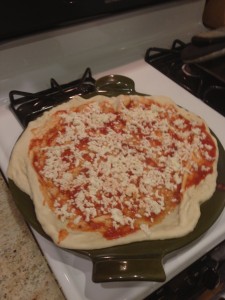 4. I make sure all my components are ready. We’re not quite at the extra-toppings phase that Casa Uborka has achieved, mostly because I like to perfect the base version of a recipe before variating things, and I’ve only just mastered (or not quite, FORESHADOWING) this process. Once the dough hits the stone, I have to move quickly to sauce and cheese everything, and then slide it into the oven. Unless …
4. I make sure all my components are ready. We’re not quite at the extra-toppings phase that Casa Uborka has achieved, mostly because I like to perfect the base version of a recipe before variating things, and I’ve only just mastered (or not quite, FORESHADOWING) this process. Once the dough hits the stone, I have to move quickly to sauce and cheese everything, and then slide it into the oven. Unless …
5. … medical plot twist! I burned my upper arm when it touched the stone, as I lowered it into the oven, and now I have a welt the size of a happily well-fed slug. I did not photograph this for you, since I respect your delicate sensitivities.
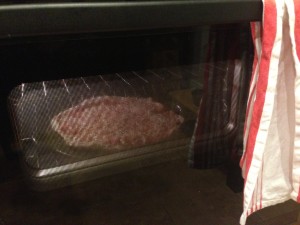 6. For the 7-9 minutes that my pizza takes to cook, I do two things: first, shred some basil and grate a few tablespoons of parmesan Reggiano to toss onto the hot pie after it’s finished. Two, I obsessively stare at my beautiful bubbling pizza pie like a creepy stalker through the oven door. Except this time, I was applying cold water and aloe to a very nasty looking burn so that was a third thing I was doing. Oh well! I plan to relish my war wound, earned in pursuit of the perfectly charred crust.
6. For the 7-9 minutes that my pizza takes to cook, I do two things: first, shred some basil and grate a few tablespoons of parmesan Reggiano to toss onto the hot pie after it’s finished. Two, I obsessively stare at my beautiful bubbling pizza pie like a creepy stalker through the oven door. Except this time, I was applying cold water and aloe to a very nasty looking burn so that was a third thing I was doing. Oh well! I plan to relish my war wound, earned in pursuit of the perfectly charred crust.
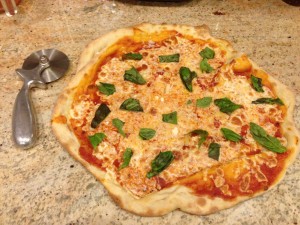 7. Once the cheese just starts to look like it has read the prospectus and is considering turning brown, I take it out of the oven and slide the pie gently onto the counter, making sure that my stone stays on the warm stovetop (I don’t want to lose an expensive pizza stone to thermal shock). I dress the pie with the basil and the finely grated parmesan, and maybe a light twirl of good olive oil, and leave it for a minute.
7. Once the cheese just starts to look like it has read the prospectus and is considering turning brown, I take it out of the oven and slide the pie gently onto the counter, making sure that my stone stays on the warm stovetop (I don’t want to lose an expensive pizza stone to thermal shock). I dress the pie with the basil and the finely grated parmesan, and maybe a light twirl of good olive oil, and leave it for a minute.
Usually here I also crow with delight.
8. The best part: now we eat the pie. I will probably also Instagram it.
*don’t know what all of these things mean? You have some reading to do.


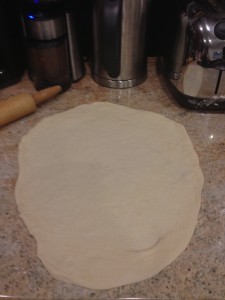
Can you please tell me more about the tomato sauce recipe?
What’s all this about Fahrenheits and “pie”? You crazy foreigners and your language.
This is good. But we need a translation. Surely “pie” has a lid??
Do you deliver? Or at least come to my house and cook one for me? I have wine.
It had never occurred to me before now, but it seems that calling it pie is regional slang. It’s very common in the New York pizza world. And now you can sound like a local when you visit! Except for those British accents, that is.
Fun fact! In New Haven CT, home of the white clam pie, it’s called “apizza”. And it’s delicious.
Many years ago while my in-laws were travelling in New England they stopped for a bite at a restaurant where my French Canadian father-in law requested ” a piece of pie”. The waiter returned minutes later with a large cheese pizza.
It’s pizza in Canada.
I’ve never heard of pizza referred to as pizza pie west or south of New York.
Can we have Uborka Proper Pie Week next week, please?
Perhaps we will, but not next week. We’ve promised to give Sev his interview. Will you write a pie post for us?
Karen, I’ve seen Neapolitan pizza recipes from the masters where there’s nothing added to the tomatoes – they just use really good canned tomatoes from Italy, crushed – but I take Smitten’s suggestion: for a regular pie, I’m using about a third of a cup of strained tomatoes (you called it passata in your post, I believe that’s the same thing) and I add a pinch of red pepper flakes, half a teaspoon or so of salt, and then a few drops of red wine vinegar for brightness and a pinch of sugar for sweetness. What’s really nice is, the red pepper becomes just a *touch* of heat or warmth in the cooked pie.
Ugh, I keep calling it pie, subjecting myself to more transnational ridicule. Sorry (not really sorry).
Fahrenheits aren’t the least of it. Slugs, grains, poundals, kips, the “British thermal unit”, we’re all mad here.
I would like to declare that I also call pizza ‘pie’ now, so there.
I also call pie, pie.
That sounds quicker and easier than my sauce, but I struggle with the idea of not adding onion and garlic. Gonna try it, though.
See, I think they’re just two different (delicious!) beasts. Do you cook your sauce at all? I like my garlicky onion-y sauces on the New York style pizzas, which I haven’t yet mastered at home because the dough is more complicated and really benefits from mixing it in a food processor, which I don’t have.
I might just throw in some pressed garlic next time, half a clove, just to see how it plays with the uncooked sauce. I’ll keep my onions for the topping, though, I love a good charred onion slice.
This is going to sound odd, but I feel like garlic and tomatoes and onion all might be considered to sort of pull in the same direction, flavour-wise, and create a very nice combination too, but letting the tomatoes stand on their own and putting the pepper flakes in there really does work.
This all sounds delicious, and if I could choke down more than a single slice, I would consider taking a whack. But that is pretty much in my past. Fortunately, and somewhat miraculously, there are a couple of places nearby in NC where you can get a decent slice of pie, as my ornery NY heart persists in calling it.
Pizza in the past is such a sad thought.